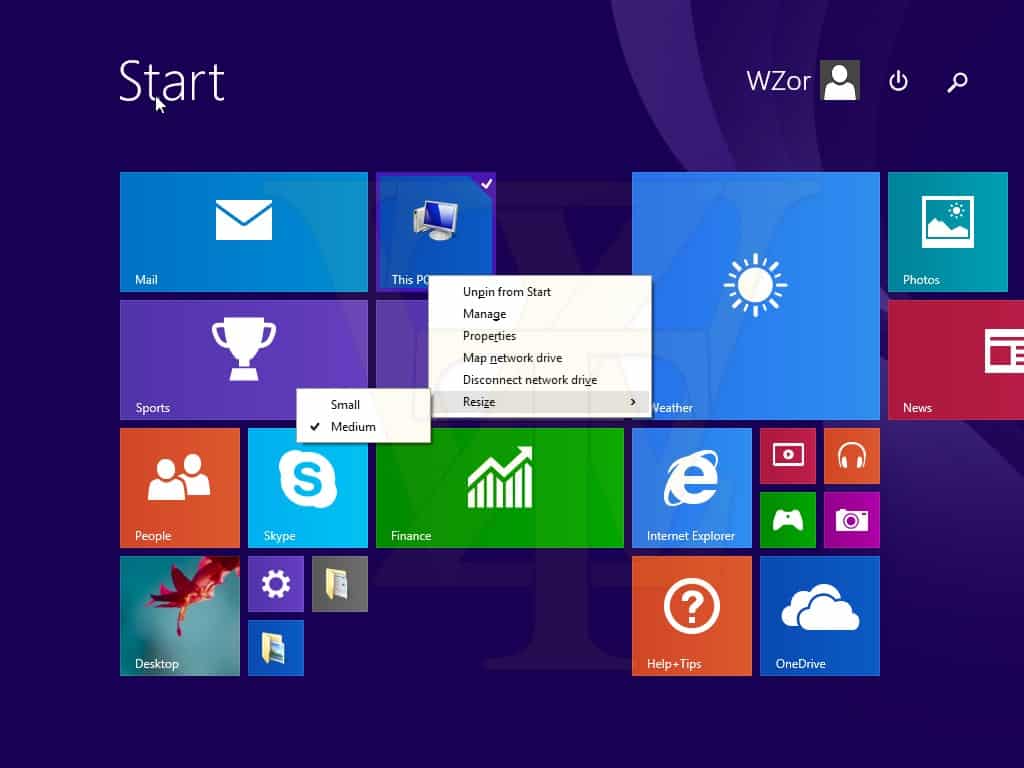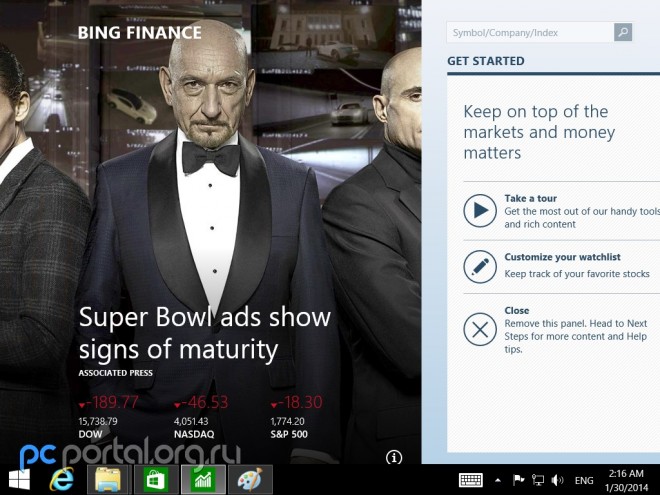Windows 8.1 Update 1 paves the way for a unified experience

When Microsoft released Windows 8, it became clear quickly that the company wanted to create an operating system that could be installed on any type of device, well, apart from smartphones that is.
What Microsoft missed at that time was that the majority of its user base was not using touch-based devices, or tablets, but desktop PCs.
The company neglected the needs of its core audience and even made decisions that would make it more difficult for users to work with the operating system.
The forced boot to the start screen, the missing start menu, and the search that always opened the start screen were three issues that the company was heavily criticized for.
Ever since that release, Microsoft has been at work to improve the usability of the operating system for desktop users. Windows 8.1 was a small step in that direction, as a boot to desktop option was implemented natively into the system.
Previously, you had to use third-party software to do so.
It appears that Windows 8.1 Update 1 will move further in that direction.
One of the most avid leakers of information about private Windows 8.1 builds Wzor claimed recently that the operating system did boot directly to the desktop after installation. This was later questioned by Mary Jo Foley who did not get a positive response from here Microsoft sources in this regard.
The feature set for Windows 8.1 Update 1 is believed to be locked-in at this point, according to one of my contacts. While there's no reason Microsoft couldn't opt to make boot-to-desktop a universal default -- or even just the default on non-touch devices/machines -- my contacts don't believe this is currently the plan.
It would make sense in my opinion to boot directly to desktop on desktop PCs, and to the start screen for tablet and touch users. Microsoft should be able to make that distinction, and as long as tutorials or guides are made to highlight the Store and start screen area to desktop users, it should not really have such a negative effect on overall use of the new interface.
Another change that is rumored to come with the update is the ability to pin apps to the taskbar. This looks like another small change, but would make sense in light of the new boot to desktop rumor.
Microsoft might pin some apps -- the store for example -- to the desktop so that non-touch users get exposed to it as well. It also means that you won't have to switch to the start screen first anymore to launch apps that you use regularly.
Another change that comes with Windows 8.1 Update 1 is the context menu that you get when you are on the Start Screen interface. A right-click displays a toolbar at the bottom or top currently only, which will change when the update gets released.
Now, you get options in a context menu that you can use directly at the position of the mouse cursor without having to move the mouse in a long arc to the top or bottom menus.
That may not be all however. A screenshot leaked by Wzor today shows the Bing Finance app and the desktop taskbar underneath it.
According to him, the taskbar becomes only available on mouse over. What's interesting here is that the taskbar is displayed when you run apps, so that you can quickly use it to switch to desktop programs, the start menu, or other taskbar features.
It is likely however that the feature won't make it into Update 1 of Windows 8.1, as it is already feature complete according to Mary Jo Foley.
It is clear that Microsoft tries to improve the attractiveness and usability of Windows 8 for desktop users, and while Update 1 is definitely a step in the right direction, provided that some of the features mentioned in this article will be implemented, it is likely that it won't convince critics of the operating system yet to make the switch.
Advertisement
















“…move the mouse in a long ark…” *arc*; an *ark* is a container or a large ship. :)
Corrected, thanks for letting me know about it.
XP on the rise. Windows 8 stagnant.
http://netmarketshare.com/
Am using StartIsBack and Windows 8.1 Aero UI on an older desktop, StartIsBack on a top-end laptop, and a touchscreen mid-range laptop. Windows 8.1 installed on those three, with 7 on two other desktops, and XP on another laptop. Must say we don’t use touch much, on the laptop that has it, guess I need to get a tablet for that. Seems MS has left most of the heavy lifting to third parties lately, at least as far as the UI is concerned. Don’t get me wrong, I am not asking for wobbly windows or a desktop cube, just seems to be Windows almost got the UI right, and then let it go to the watershed. Oh well, during the Vista days I learned to install, maintain, and dual-boot to a Linux desktop. No need to defrag there, although I did install Avast AV on Linux boxes a few times. It seems the MS glory days are over. I hope I am wrong there. Any word on the new CEO? Not good to leave investors wondering…
Everyone wants a desktop OS and a phone/tablet/phone OS. Merging them is a stupid and bad idea. If Apple and Google can get it why can’t Microsoft?
Its not stupid, actually, it’s the future, MS came too late in to the mobile/tablet ARM market, but maybe too soon to its all in one integration. I bought a surface pro and after couple days I got MS idea, I hope their mistakes will lead then to the right path. Hopefully we wont get stuck with apple/android two companies.
@sades, unified interface and eventually apps across all Microsoft platforms (phone, tablet, computer).
Can you explain how it is the future?
A step in the right direction. Now they need to fix getting into Safe mode (not to mention getting rid of the number of steps you have to use currently).
I am not interested in Win8 and it’s next releases until they integrate fully both environments like Jay Machalani did in his mockup: http://jaymachalani.com/blog/2013/12/12/fixing-windows-8 and give users actually choice to use interface during OOBE installation phase.
I just read an article about the reluctance of corporations in India, where XP is still very widely used, to adopting Win 8. Enabling a desktop default would be very reassuring to professionals who need AutoCad, GIS software, Photoshop, etc. Maybe these moves by MS will be able to convince more corporate users like those in India to make the move to Win 8.
On the impetus for Win 8: personally, I’d guess that the decision to make an app-based touch-friendly Metro was made by top planners. It reeks of Higher Management Strategic Thinking.
Free and open-source Windows executables have proliferated. Some relatively large users are trying out FOSS programs like LibreOffice instead of MS Office. Is it possible that one facet of Microsoft’s move to apps available in a MS-controlled environment, instead of executables, is to assert control over a software ecosystem that they perceived as escaping from their corral?
Or am I being very stupid there? ;)
I agree that the decision must have been made high up the food chain because of how well “mobile” did.
Finally. It makes you wonder who their head of UIX was with the OS ignoring so many UI guidelines. I suspect it was a programmer. Bad UI is usually down to programmers thinking they know about UI.
His name is Steven Sinofsky, maybe you heard of him. ;)
I have my doubts that it was down to the programmers. I suspect it’s more likely that the sales and marketing bods wanted to make a big deal out of the Start screen and the new Windows Store Apps by shoving it in peoples faces where they couldn’t just ignore it.
@farmers
Yeah, let the market decide. Oh wait.
Continue your descend into obscurity, Windows 8.
Or it could have been a ‘UI guru’ who didn’t actually have the first idea of how people really want to use their computer. The amount of ‘babble’ being spoken in defence of Metro after the release reminded me of the emperor’s clothes story. The only people who could see it for the steaming pile of whatever that it was were everyday users who made no pretense of trying to understand the babble. Unfortunately these people were then called either trolls or just people who didn’t ‘get it’.
While I’m on the subject of ‘gurus’ – what kind of guru came up with a design for apps that totally does away with givng the user clues what to do once they’re in it ? One of the main reasons I’ve had users wanting to be rid of Windows 8 was the fact many of them were totally lost once they accidentally opened one of the new apps. Many of them said they ended up switching off the pc, as they couldn’t find out how to get out of the thing. But – I’m sure the gurus are on top of that by now, after all the feedback they’ve had. If they’ve paid any attention to it, of course ….
I’ve used Windows 8 quite happily since before the release. However, I did end up installing Classic Start Menu. I found that although I *could* use it via the Start Screen, it was making simple things too much like hard work. Maybe I’m in the minority there – apparently Microsoft tell us that nobody has been using the menu part of the Start Menu for years anyway, ever since the Search facility was added. Hmm, as someone who supports home users with their pc problems, that was an enlightenment for me. I was aware of that facility, although I rarely used it – again, for normal use it seemed more clumsy than just a couple of clicks with the mouse. Also, as part of my job, I’ve made many home users aware of the search facility. None of them had been aware of it either till I showed it to them, and none of them to my knowledge went on to use it regularly – all preferring the easy way of doing things. But apparently the ‘metrics’ fed back to Microsoft by Windows machines show that there’s a vast number out there who do use it avidly. Well, they obviously don’t live in my part of the world ….
All of this becomes baffling for me; since I am using Start8 by Stardock and Start Menu 8 by IOBit, I am wondering what will by my end result if and when installing 8.1 and 8.1 + Update 1. I would think Microsoft had programmers with enough vision and capability that a user could easily choose a default UI at boot or installation. Odd–oh well.